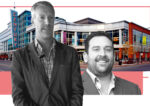Blame the pandemic?
Or is it the rise in interest rates?
Perhaps it’s a slow-rolling combination of those two macro factors that have stalled three would-be Chicago megaprojects—but they are moving along slowly in any case, as a roundup from Crain’s indicated.
The mega-projects that have had a green light since pre-pandemic days of rock-bottom interest rates hold the potential to form a triangle of mixed-use master plans that could have reshape the center of Chicago from North Side to South Side, and Loop to Lakefront.
They’re all still potential, for the most part, including:
- Sterling Bay’s Lincoln Yards north of downtown, which was cleared for takeoff in 2019 with an ultimate goal of 14.5-million square feet of office, residential, retail and entertainment along the Chicago River. The developer paid $100 million for an old industrial site and set out to create a hub that would tie together the adjacent Lincoln Park, Bucktown and Wicker Park districts.
Sterling Bay has one building up and running, a 320,000-square-foot life science center, and has done some work on a river walk. Its chief financial backers on the project — New York-based J.P. Morgan Asset Management and Lone Star Funds in Dallas — are looking to sell off their stakes.
Sterling Bay is in talks with Los Angeles-based Kayne Anderson Real Estate, a new investor, and appears to have recently reworked terms of a $126 million loan on the project from Bank OZK.
Economic and social trends, as well as local tax rates, are factors in the project.
“Lincoln Yards is dealing with the same difficulties as every project in commercial real estate right now.High interest rates, lack of liquidity in the market, property taxes that are among the highest in the country, and reduced demand for office product, resulting from work-from-home post-pandemic, have made even the most attractive developments like those in Fulton Market and Lincoln Yards more difficult to execute,” Sterling Bay Managing Principal Keating Crown told Crain’s.
- Farpoint’s Bronzeville Lakefront on the South Side, which aims to turn the old Michael Reese Hospital and Medical Center site into a $3.8 billion health-themed project.
City officials followed up plans for an Olympic Village that were rendered moot with the rejection of their bid for the quadrennial games in 2016, by picking Farpoint and its CEO Scott Goodman to lead a team to reimagine the site. The team put together in 2017 included McLaurin Development Partners, Loop Capital Management, Chicago Neighborhood Initiatives and Bronzeville Community Development Partnership.
There’s been some progress on infrastructure for the site: 2.5 miles of new streets are in the works. Goodman said he expects construction to go vertical sometime next year, with residential and retail expected to come first.
“We are working towards being true to our commitments and also being mindful of the marketplace and being sure we’re building things that are in demand and economically feasible,” Goodman said. “So much is dependent on the economy and on construction costs and on interest rates, but we expect to go vertical as quickly as possible.”
Goodman also has pitched the Bronzeville Lakefront as a location for the Chicago Bears’ proposed stadium, which seems to be a long shot.
- Related Midwest unveiled a $7 billion plan for thousands of units of housing and commercial space in 2018, and has spent much of the past nine years working on approvals, infrastructure and lining up partners, including the University of Illinois, for early phases of development.
More recently the developer has engaged Chicago White Sox owner Jerry Reinsdorf about the possibility of a new stadium at The 78, which is named for its ambition of growing into the city’s 78th officially designated neighborhood.
Related Midwest’s preliminary plans for a stadium would include adjacent high-rise apartments, a hotel, entertainment spots and a parking garage.
The project had been seen as hosting 10,000 residential units in its original form but would feature about half that number — with 20 percent of them affordable — in conjunction with a ballpark.
The stadium plan is likely dependent on some subsidies from the state, which looks to be a tough row to hoe in Springfield.
Related Midwest President Curt Bailey said the developer plans to work with other teams, such as the Bears and the Red Stars soccer team, both of which are pushing for stadium subsidies.
These three megaprojects aren’t on a fast track, but they are within a tradition of big developments that take decades to get completed, including the decades-long processes behind the mixed-use Lakeshore East, and Central Station, a transportation terminal turned residential development.
Read more



